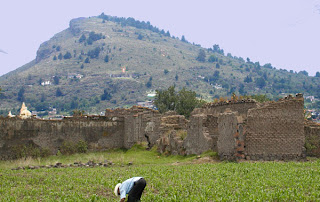
We excavated this ceramic object in the fill of a terrace. Over a foot in length, it is shaped in low relief and was clearly broken off at the right edge. What is it? It looked vaguely familiar to me, but I could not identify it. We called it a “ceramic relief” at first, a catch-all category for carved or molded ceramic objects that were probably part of something larger. At our previous excavations in Yautepec, we could identify that larger object for only a few of the ceramic reliefs. For the present larger relief, I was only certain that I had never excavated such an object before.
I emailed this photo to a couple of colleagues to ask for help its identification. Leonardo López Luján responded right away with the correct identification – this is one of the vertical reliefs that stick out to the sides of large effigy censers. As soon as he said “brasero,” I knew exactly what he meant. These censers, often depicting the god Tlaloc, have been excavated at the Templo Mayor of Tenochtitlan and at Tlatelolco, and several unprovenienced (looted) examples are in museum collections. The relief depicts the clouds or mist associated with the rain god Tlaloc. The whole censer in the photo is in the Museo Nacional de Antropología in Mexico City.
For many years I have been worried that if I excavated a fragment of a large complex censer or ceramic sculpture, I would not be able to identify the piece. These objects break into numerous strange fragments that do not occur on normal ceramic vessels. When sorting a bag of potsherds, these fragments stand out as unusual, but it is hard to match them to specific large objects. Well, my worries proved correct this time.
The censer that this relief was part of must have stood over a meter in height. It would not be unusual if such a censer was used at one of the large temples at Calixtlahuaca. But what was a large piece of one doing within the fill of a terrace? Where are the rest of the pieces? The terrace was in a residential-agricultural area of the site, and one of the houses we excavated (unit 311) was built on the terrace (close to, but not directly over, the relief fragment). We can’t answer these questions yet. Leonardo López told me that Tlaloc censers like this were associated with Stage IVB of the Templo Mayor of Tenochtitlan, relatively late in its history. This might suggest that the terrace fill, and thus the house built on the terrace, were also late within the Late Postclassic period; only time (and dating work) will tell.
I want to make a larger point here. One reason I was unable to identify this piece at first is the poor level of publication of the large and fancy ceramic objects produced and used by the Aztecs. Although examples of these large censers are published in museum catalogs and other places, there is no published analytical study of them. Someone should pull together and publish the known examples with illustrations and descriptions. These should include detailed illustrations of their many odd pieces that will help field archaeologists like me identify them when we find them. There are enough examples in museums (in Mexico, the U.S. and Europe) to do this, but many museums don’t even know what they have in their back rooms.
I am not trying to justify my ignorance (well, perhaps only a bit). Some of these pieces HAVE been published and I should have identified our relief (a big thank-you to Leonardo López Luján). But the lack of publication of large fancy Aztec ceramic items is a real obstacle to scholarship, part of a larger problem with the inaccessibility and lack of publication of museum collections of Aztec art and artifacts (I have published a comment on this in the Nahua Newsletter:
This is the first piece of a large complex Aztec censer we have identified from our excavations at Aztec provincial sites. But how many more have we excavated but not recognized in the past? At Calixtlahuaca we are making a greater effort to separate large strange ceramic pieces than on past projects (we have a large collection of Type 80, unidentified ceramic fragment), and we are taking a closer look at such items. What were they doing in residential and agricultural contexts at Calixtlahuaca? ¿Quien sabe?
























